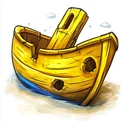How to Draw a Shipwreck
Learn how to draw a shipwreck with these step-by-step instructions. Capture the history and drama of a shipwreck in your artwork. Perfect for artists of all skill levels.

Materials You'll Need
- Pencil
- Paper
- Eraser
 Learning how to draw a shipwreck offers a unique opportunity to explore themes of history, mystery, and adventure captured on canvas. The image of a once-majestic vessel now resting at the ocean's depths evokes emotions ranging from nostalgia to curiosity. Each detail of the shipwreck tells a story—the creaking wood, the torn sails, and the barnacles that cling to its hull all contribute to the narrative that unfolds in your artwork.
Learning how to draw a shipwreck offers a unique opportunity to explore themes of history, mystery, and adventure captured on canvas. The image of a once-majestic vessel now resting at the ocean's depths evokes emotions ranging from nostalgia to curiosity. Each detail of the shipwreck tells a story—the creaking wood, the torn sails, and the barnacles that cling to its hull all contribute to the narrative that unfolds in your artwork.
In this step-by-step guide, we will embark on an exhilarating journey through the process of drawing a shipwreck. From the initial rough sketch to the final intricate details, we will provide you with the techniques and tips you need to effectively capture this evocative scene. Whether you're an experienced artist or a beginner, this guide will help you harness your skills and imagination to bring a story of maritime ruin to life.
So, grab your pencils, sketchbook, and an array of drawing materials, and let's dive into the captivating world of shipwreck artistry. With each stroke, you'll not only create a stunning piece of art but also engage with the rich visual history that these remnants of the sea represent.
Materials Required:
Before we begin, make sure you have the following materials ready:
- Drawing paper or sketchbook
- Pencils (HB, 2B, 4B, and 6B)
- Eraser
- Blending stump or tortillon
- Reference images of shipwrecks (optional)
Having these materials ready will ensure a smooth drawing experience and allow you to create a detailed and realistic shipwreck illustration.
Step 1: Sketch the Basic Shape
Start by lightly sketching the basic shape of the shipwreck. You can begin with simple geometric shapes like rectangles, triangles, and circles to outline the main structure of the ship. Use light and loose pencil strokes to maintain flexibility in making adjustments later.
Step 2: Add Details to the Shipwreck
Now, it's time to add more details to your shipwreck drawing. Look at reference images or use your imagination to include elements like broken masts, torn sails, and damaged hull. Pay attention to the angles and proportions to ensure accuracy in your representation.
Step 3: Enhance the Shipwreck Structure
To give your shipwreck more depth and dimension, start adding shading and shadows. Use a darker pencil, such as 4B or 6B, to create contrast and make certain parts of the shipwreck appear more three-dimensional. Focus on areas where light would naturally hit and cast shadows.
Step 4: Create Textures
To make your shipwreck drawing more realistic, it's important to add textures to different surfaces. Use cross-hatching or stippling techniques to create the illusion of wood grain, rust, or worn-out metal. Experiment with different pencil pressures and strokes to achieve the desired effect.
Step 5: Incorporate the Surrounding Environment
A shipwreck doesn't exist in isolation; it is often surrounded by a rugged coastline or the vastness of the ocean. Extend your drawing to include rocks, waves, cliffs, or any other elements that would complement the shipwreck. This will add depth and context to your artwork.
Step 6: Refine the Details
Take a step back and assess your shipwreck drawing so far. Look for any areas that need refining or additional details. Erase any stray lines or smudges that may distract from the overall composition. Use a fine pencil, like an HB or 2B, to add intricate details like rust spots, ropes, or broken planks.
Step 7: Add Tonal Values
To create a stronger sense of light and shadow, incorporate tonal values into your shipwreck drawing. Observe where the light source is coming from and darken the areas that are in shadow. This technique will add realism and depth to your artwork.
Step 8: Finalize the Drawing
In this step, go over your shipwreck drawing, making any final adjustments and adding any remaining details. Take your time to closely observe your drawing and ensure that it adequately captures the essence of a shipwreck. Add highlights and refine shadows to create a more polished and professional-looking artwork.
Tip: To effectively capture the essence of a shipwreck, start with a dynamic composition by utilizing the rule of thirds; position the ship's hull or a significant detail along these lines to create visual interest. Begin your sketch with loose, flowing lines to outline the ship's structure, allowing for organic shapes that mimic the natural decay and weathering of the wood. Use a range of pencils—start with a softer pencil (like 4B) for bold outlines and switch to harder pencils (like H) for finer details such as barnacles or rust patterns. Don't forget to incorporate shading techniques like cross-hatching or stippling to convey depth and texture, especially where light meets shadow on the wreckage. Finally, reference real shipwreck images to inspire your detailing and ensure authenticity in your artwork!
Conclusion
Drawing a shipwreck can be a captivating artistic endeavor, allowing you to explore the hidden stories and emotions associated with these remnants of the past. By following these step-by-step instructions, you can create a visually stunning shipwreck drawing filled with history, drama, and intrigue. So, gather your materials, unleash your creativity, and enjoy the process of bringing a shipwreck to life through your art.